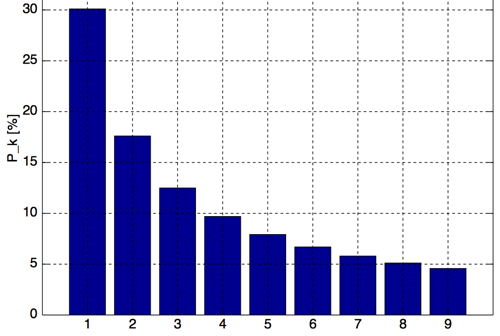Irrelevant Topics VII
in Physics
Topics:
Benford's Law
Statistics
Negative Specific Heat
Physics
Real Computability
Mathematics, Physics
Benford's Law
one is not the loneliest number
History
Simon Newcomb (1881) noticed the wear on logarithmic tables was not uniform. Suggested that the a priori assumption of the most significant digit distribution was not uniform. Frank Benford (1938), physicist, tested the hypothesis over many datasets.
What is Benford's law?
Benford's Law (in base 10)
Benford's Law (in other bases)
Examples
Benford's original paper took data from many disparate sources
- Rivers (335)
- Population (3259)
- Physical constants (104)
- Newspapers (100)
- Specific Heat of Materials (1389)
- Pressure (703)
- Molecular Weights (1800)
- Drainage (159)
- Atomic Weights (91)
- and (5000)
- Readers Digest (308)
- (900)
- Death Rates (418)
- Street Addresses (342)
- Black body radiation (1165)
Distribution of Distributions
Benford's law applies not only to scale-invariant data, but also to numbers chosen from a variety of different sources.
As the number of variables increases, the density function approaches that of the above logarithmic distribution.
It was rigorously demonstrated that the "distribution of distributions" given by random samples taken from a variety of different distributions is, in fact, Benford's law.
Why might this be so?
Exponential growth
Numbers are not uniformly distributed, but the logarithms are...
Scale Invariance
If an underlying distribution exists, then it must be scale invariant. The only continuous distribution that satisfies this is logarithmic.
Mixing of Distributions
While drawing from a single Gaussian would fail, multiple Gaussians from multiple sources would follow Benford's law.
Can it fail? (yes)
Numbers that fail to span large orders of magnitude, or numbers that aren't "numbers" such as the lottery or telephone numbers.

Favorite Examples
Benford's Law is now considered admissible evidence
for fraudulent claims in forensic accounting.
Some numerical distributions follow Benford's law exactly,
such as , and the Fibonacci numbers.
The 54 million real constants in Plouffe's
Inverse Symbolic Calculator database follow Benford's law.
Negative Specific Heat
getting more by pushing less
Something Reasonable
One expects that the average internal energy , of a system in contact with a thermal bath should increase with , the bath temperature.
Why might this be so? Consider
Recourse to the Virial theorem
Astronomers have experience with such systems. If the system obeys the Virial theorem with potential energy that scales as with external edge pressure and volume
Isolated gravitational fields give , and
Simple 3-level model
Assign a simple (Boltzmann) transition rate, but couple states and to different thermal baths, say and . For simplicity, disallow .
Using the Master equation, the average energy is
There is a range of values where
['height:300px']
The intuitive explanation is the creation of the barrier
of the forbidden .
Negative Conductivity
Suppose a particle moves stochastically but is driven (say by an electric field, with driving energy ) down two lanes. The particle has the following movement probabilities, where
- 1, for crossing lanes
- x, for moving upstream
- 1/x, for moving downstream

Negative Conductivity
In the uniform case, this gives a current density that is always positive
Now introduce a barrier

The conductivity for sufficiently large !
Real world examples
Biological membranes, different heat
coupling in the membrane and outside
Brownian noise with a driven diffusion
Negative mobility and sorting of colloidal particles
Real Computability
a waste of the number line
Preliminaries
We must understand two things first:Computability
Cardinality
What makes a number computable?
Computable Numbers
How can be computable if it has an infinite amount of "information"? Consider the following program
Cardinality
How do you compare sets?
We get that . How can we do that if we can't count them? We say that two sets have the same cardinality, , if we can find a bijection (i.e. a mapping from one to another)
Infinite sets
Common fields
- Whole numbers
- Natural Numbers
- Rational numbers
- Real numbers
This works for infinite sets as well (see Irr. Topics 3).
Think about vs .
...
Thus .
Cantor and aleph-naught
The smallest infinity is , but
While there are just as many fractions as integers, there are "more" real numbers than fractions! (details: if the continuum hypothesis holds ).
Uncomputable numbers
Think of all possible programs one could write (say in python), let this set be . Some of these programs run and spit out an answer in a finite amount of time and halt, some of them run forever (some programs have syntax errors and never run, give them a run time of zero).
There is a real number, called Chitin's constant, that represents the average halting probability for all programs.
is not computable. This is the Church-Turing thesis, and is directly related to Gödel's incompleteness theorems.
How big is ?
Since the programs in can be enumerated,
we must have the case that
This means that all computable real numbers
are equal in size to the whole numbers.
Which means that a random point on the
real number line is not-computable.
This implies that (almost) every number we use in physics amounts
to an infinitesimal fraction of the real number line!
The question of physics and the real number line is intimately tied to the discreteness of Nature.
If one built a machine (more powerful than Turing) that could use all of the real numbers, one could solve all of the "hard" problems easily. It would imply that .